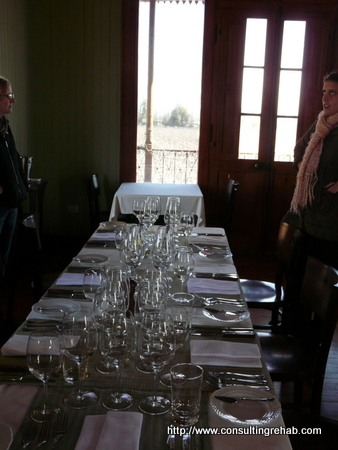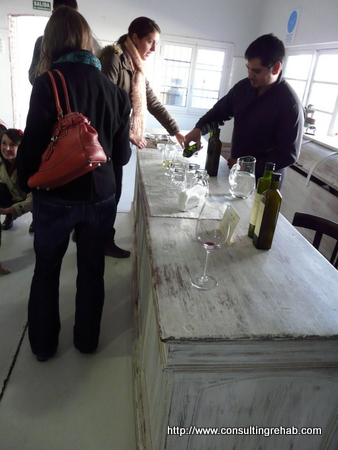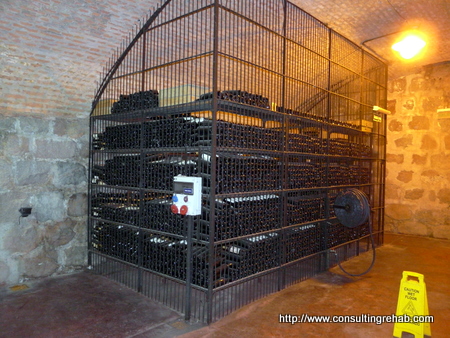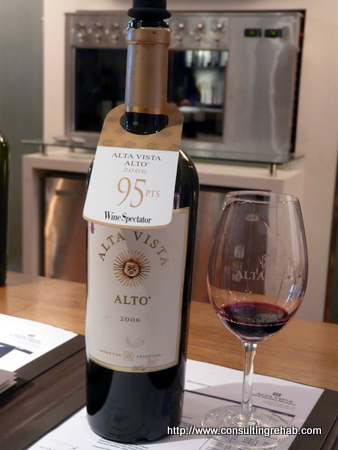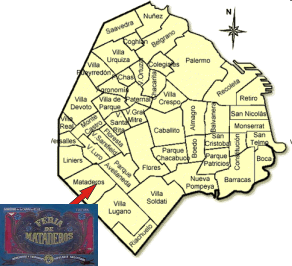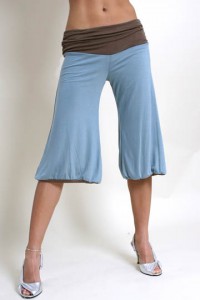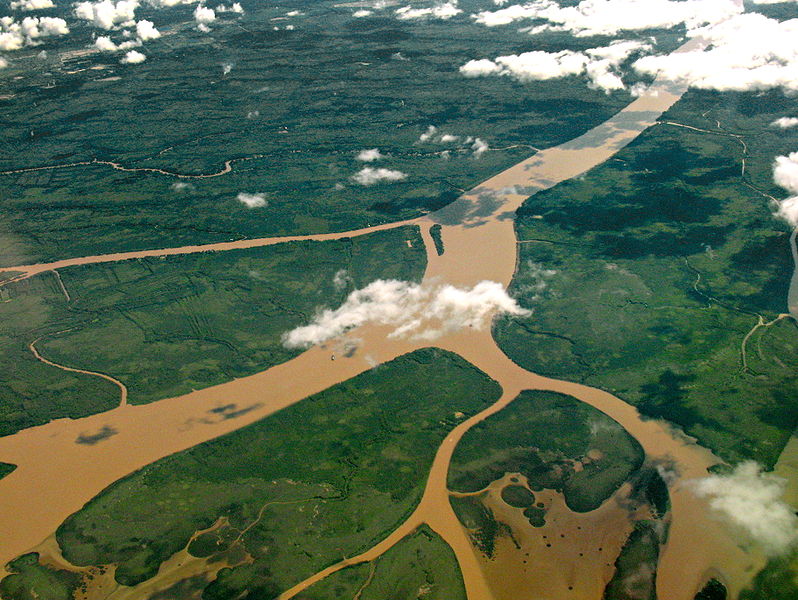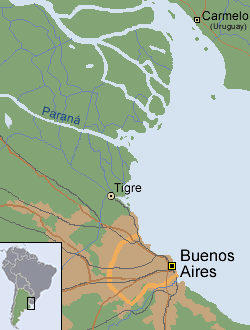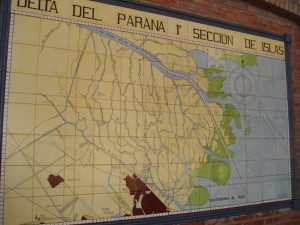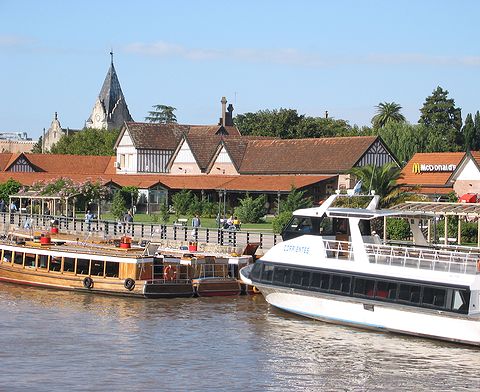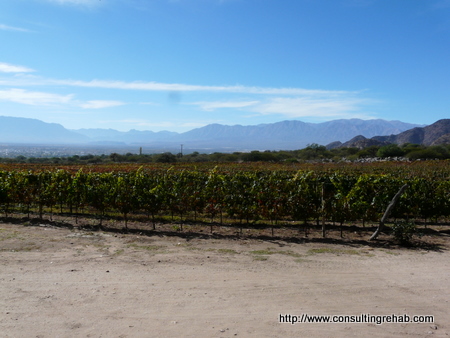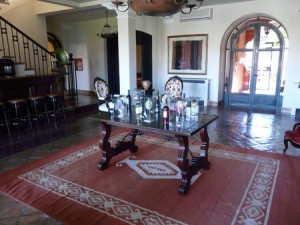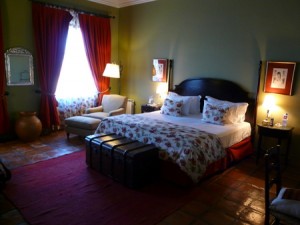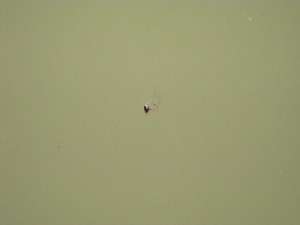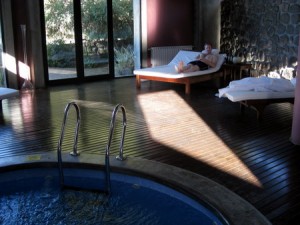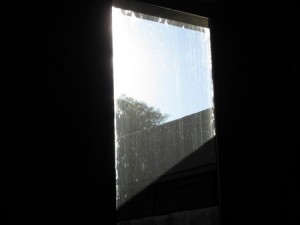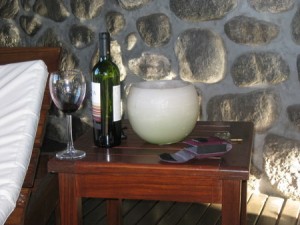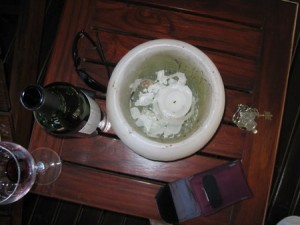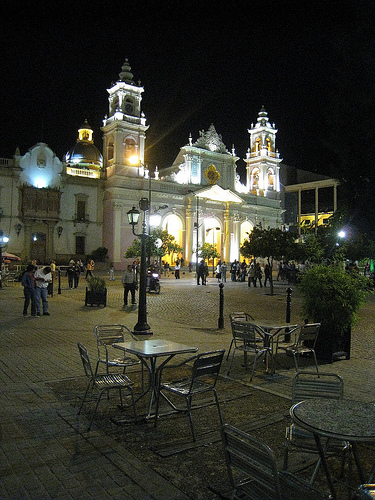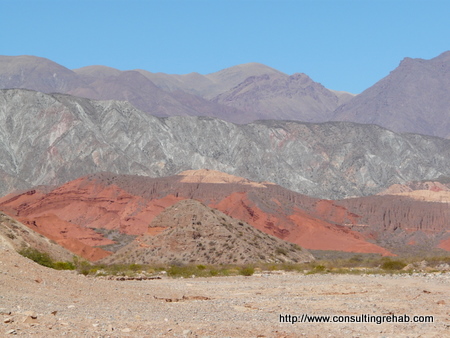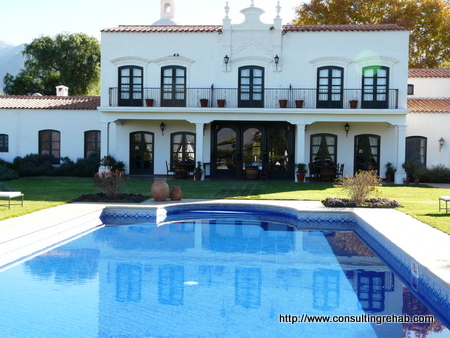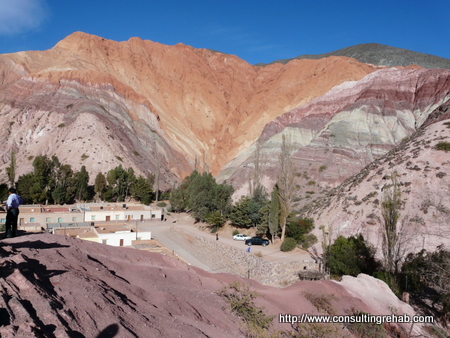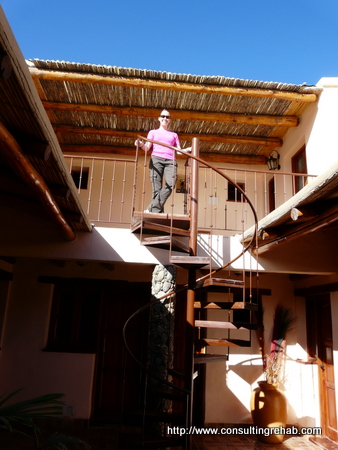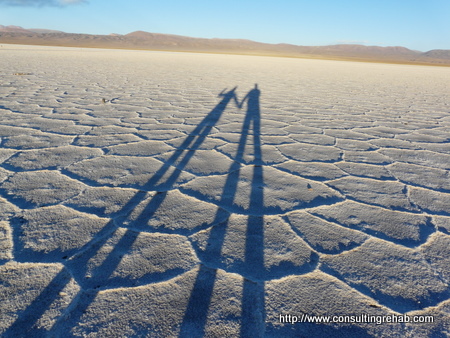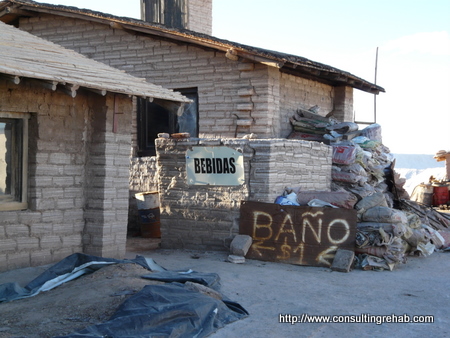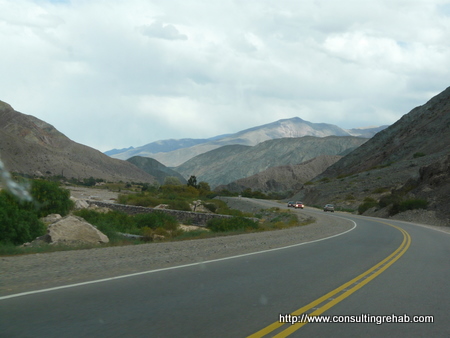We decided to use Ashley’s visit as an excuse to go wine tasting in Mendoza (the top wine-producing region in Argentina, especially known for its malbecs). We only had 2 1/2 days there before heading to Santiago, but we really enjoyed it – here’s a quick trip report:
Wine tasting: Choices, choices, choices!
There are several different wine valleys within an hour or so of Mendoza, the closest of which is Lujan de Cuyo. Wineries aren’t the same as in California, where you can just show up and do a tasting – here you have to make an appt. in order for the guard at the gate to let you in, and you usually have to go on a tour of the winery before you get to the tasting. As for how to get there, there are a couple of options:
- Bike to the wineries: Basically rent a bike and cycle around to various wineries. This is the cheapest option, but not the safest: people have been mugged, and we’ve also heard of traffic accidents since bikers share the road with everybody else.
- Private driver: Hire somebody to drive you around for the day, but you make all the appointments, so you have to know where you want to go–this is harder than it sounds, there are ~1300 wineries in the area!!
- Private guide: Same as the above, but the driver makes the appointments and supposedly knows a lot about wine and has contacts at the wineries. There are a dozen of these on Trip Advisor, all highly recommended (usually by people making their first post), and at least 4 of them are named Javier.
- Small group tour: Tours arranged by a private company, usually with a max of 6 people per tour.
- Large group tour: Think tour bus.
We ended up going with the small group tour – we’d heard great things from several friends who had gone, as well as numerous positive reviews on Trip Advisor. We chose Trout and Wine, one of two main companies running such tours from Mendoza, and it was awesome (the other is Ampora which we also heard good things about)! Our guide was Michelle, an American who studied abroad in Mendoza during college. She was great – very friendly, knew a lot about the area and the wineries and great to spend the day with. It was very cold the day we went, which made the vineyard tours a little less comfortable, but it was still awesome. We visited 4 wineries, including lunch at one:
- Kaiken: Just started giving tours and tastings about 4 months ago. This was our first stop of the day and was freezing cold when we started the tour out in the vineyards – seriously, we could see ice on the ground.
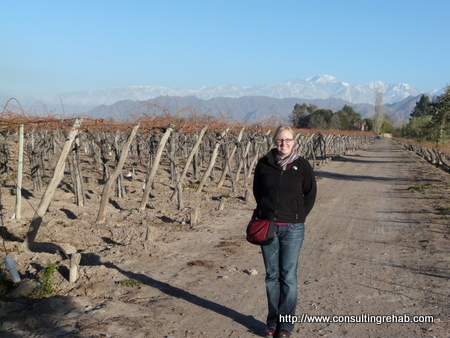
Cold but beautiful - how often do you get to visit wineries with the snow-capped Andes looming in the background?
After a tour of the vineyards and facilities, we went to the tasting room to try their two high-end reds. Unfortunately, the tasting room wasn’t much warmer than outside – the wines were too cold to really taste them, so our host suggested we warm them up with our hands . . . not that our hands were any warmer than the wine after half an hour out in the freezing cold! We think the wine was good, but again, it was hard to tell.
- Sottano: This was our favorite of the day, due at least part in to our awesome host, Diego. He greeted us all with a glass of rose sparkling wine then gave us a quick (~10 min) tour/history of the winery before moving us into the (heated!!!!) tasting room. The tasting room has a glass floor that looks into the barrel room below – very cool. We tasted 4 different wines here, which were all very good, and had a great time chatting with Diego throughout the tasting – very casual, very fun.
- Club Tapiz: We did a 5-course lunch at Club Tapiz in the second floor of the restaurant, overlooking the vineyards. Wines were paired with each course (and poured generously) – this was a bit less of a tasting (without a lot of description of each wine as it was served) and more just drinking. Food was not out of this world but definitely good and went well with the wines – we like having steak for lunch.
After lunch, we headed downstairs to do an olive oil tasting (they also have olive trees at the winery), but the olive oil was frozen solid in the tasting room . . . upon discovering it was frozen, they told us that this is the sign of a high-quality olive oil which is either an interesting fun fact, or an impressive bit of improvisational olive oil salesmanship–we are equally appreciative either way.
- Alta Vista: Our last stop of the day, this is a classic winery for tasting in Mendoza. We did a quick tour of the winery, including seeing the old concrete tanks (something they use just in Mendoza) and the owners’ personal stash.
Our tasting upstairs was great fun – the host was super friendly and poured great wines (we brought one to Santiago with us, will make sure it’s still good when we haven’t been drinking for 6 hours). We also tried the Alto wine, their top wine – great way to end the day!
At most Mendoza wineries, you’re typically expected to go on a tour before the tasting. We’ve done a number of winery tours (especially while living near Napa and Sonoma) and weren’t really excited about going on a tour at every winery and hearing the exact same thing, but we were pleasantly surprised by our experience in Mendoza. The tours were very informative and we definitely learned new things – for example, at Kaiken we learned that you can graft branches for one type of grape onto the rootstalk of another in order to shorten the time from planting to production – we saw malbec vines grown from a chardonnay root base (didn’t know you could do that!).
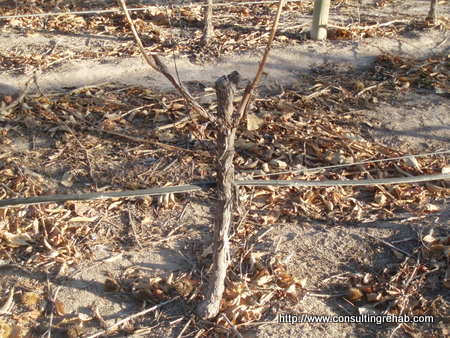
Old chardonnay rootstock grafted to malbec branches - produces malbec grapes faster than planting new vines and waiting for them to mature
The wineries also did a nice job of not all telling us the exact same thing (we suspect this was thanks to Trout & Wine), and we only did a full vineyard tour at one winery, while the others focused on different parts of the production process or showing us what was unique about their wines/facilities. We definitely came away with new knowledge about the winemaking process.
Overall, we were impressed with our experience with Trout and Wine. It’s expensive relative to other options (we paid US$125/person during low season; high season rate is $150), but it was worth it. High-quality transportation (mini-bus), great guide, tastes of reserve/high-end wines and a very customized experience – we were the only people there at every winery we visited. Also, when you consider the base costs for wine tasting on your own, this wasn’t much more. Average tasting fees are around US$10 (just for the basic wines, not the higher end ones we tasted with Trout & Wine), and the winery lunches are typically ~US$45, so that’s US$85 for 4 wineries, even before transportation. And they sent a bottle of wine to our hotel before the tour as well – nice touch!
On day 2, we took a taxi to Clos de Chacras winery which was about 20 minutes away and did a tour/tasting there. The tour was pretty good, but the tasting was somewhat mediocre (though possibly we had destroyed our palates and livers the previous day). While it was relatively easy to do a tasting here (just had the hotel call and make a reservation and then hailed a cab), the seemingly lower quality tasting and more generic tour made us appreciate our experience with Trout and Wine all the more.
Where there’s wine, there’s food!
The Mendoza food scene isn’t exactly Buenos Aires, but we did find a few great places to eat. Dinner the first night was at Azafran – we’d read online that you go into the cellar with the sommelier to choose your wine. In reality, it wasn’t quite as cool as it sounded, but they do have a wine room in the front of the restaurant (with a window out to the street – wonder how that works for preserving the wine?). We also went to Francesco, a fancy-ish Italian/pasta place off of Plaza Independencia – really good pasta but expensive for Argentina. And check out what we walked past on our way to the restaurant:
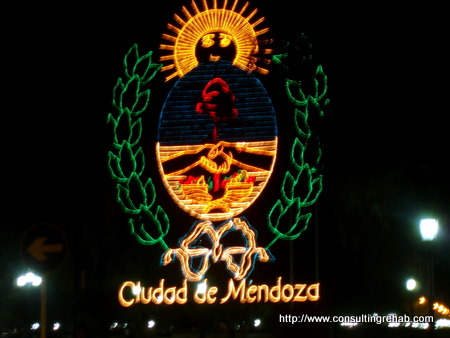
At first we thought this was a massive leftover Christmas decoration hanging over Plaza Independencia, but apparently not. Definitely . . . weird.
We also visited the much-acclaimed Vines of Mendoza wine bar. Lesson 1: not open on Monday (when we tried to go, of course). When we went back on Wed., we were impressed with the wine selection and the knowledge of the bar staff, but annoyed that we couldn’t buy a bottle to share amongst the 3 of us. Apparently, they only sell by the glass and wouldn’t sell us a bottle . . . The place was freezing, and people kept coming in and out of the tasting room every minute or two the whole time we were there, usually leaving the door wide open behind them. Might be better in summer, but we don’t really get all the hype about this place after visiting. They’ve got a good website with info about stuff to do in Mendoza though . . . and they have a good cheese plate.
Where to stay? No easy answer
We learned through planning this trip that Mendoza doesn’t exactly have a plethora of great places to stay that are affordable. The market is roughly divided into super-expensive top end hotels, guesthouses/B&Bs with mediocre reviews, business hotels and hostels. We had originally wanted to stay in a cute B&B, but even the top rated ones on Trip Advisor had some pretty bad (and consistent) reviews.
We decided to stay in the Hotel Aconcagua, a business hotel located about 3 blocks from Plaza Independencia, which was super convenient. We booked a triple room online and they ended up giving us two adjoining rooms, which was great. The rooms were clean and quiet, breakfast was included and the staff was very friendly and helpful.
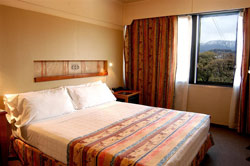
Nothing fancy but perfectly nice - clean, quiet room and great location ~2 blocks from Plaza Independencia
The only problem we had were the obnoxious children running (yes, literally running) through the lobby while we were downstairs using the wireless. For example, these 6 children ran to and fro through the lobby for a good 2 hours, at one point playing on the luggage dolly and slamming it into a glass dividing wall, at other times jumping over the reception counter to take pens out of the hands of the front desk staff – seriously, we saw this happen. Keep in mind the parents were sitting chatting in a corner of the lobby and made no effort to control or discipline their children at any point over the 2 hours nor were they at all concerned by our very explicit gestures of displeasure. We’ve noticed similar, ahem, behavior, throughout our time in Argentina – have we just had bad luck, or have others noticed this phenomenon? Anybody have an explanation for what’s going on?
En fin
We definitely recommend Mendoza for wine if it’s in your budget – from what we know thus far, the wine’s better there than in Chile. We had been considering skipping Mendoza during our time in Argentina since we weren’t impressed with the wine tasting experience in Cafayate, but we’re very glad we did it – the experience is completely different and really worth the trip (and we found it to be unique and worthwhile even compared to our frequent trips to Napa/Sonoma). There are a bunch of outdoors things to do as well, but we unfortunately weren’t there at the right time of year. Overall, great trip – we just wish it had been warmer!!
Here’s the full album of pics from our trip if you want to see more: Our Mendoza pictures
Resources
We used several different resources for planning our trip. If you’re doing the same, these might be useful:
- Trip Advisor: Particularly the forum (for info on different wine tasting options) and the hotel reviews
- A Gringo in Buenos Aires: Good post on Argentine wine
- Globetrotters travel blog: Detailed Mendoza trip report
- Other travel blog: Detailed Mendoza trip report


